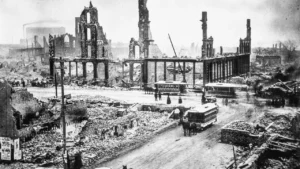On October 8, 1871, a devastating conflagration ignited in Chicago, forever altering the landscape of the city and leaving a lasting impact on its residents. Known as the Great Chicago Fire, this catastrophic event resulted in the deaths of approximately 300 people and the destruction of a large portion of the city, making it one of the most significant urban disasters in American history.
The Origins of the Fire
The origins of the Great Chicago Fire are often attributed to a barn owned by Patrick and Catherine O’Leary. According to popular lore, the fire began when a cow kicked over a lantern in the O’Leary barn, igniting a blaze that quickly spread. However, the true cause of the fire remains uncertain, with various theories proposed over the years.
Regardless of its origin, the conditions in Chicago at the time contributed significantly to the fire’s rapid spread. The city was experiencing a severe drought, which left buildings and streets parched and highly flammable. Many structures were made of wood, and the tight spacing between buildings created an environment where flames could leap from one structure to another with alarming speed.
The Fire’s Destructive Path
Once ignited, the fire raged uncontrollably, fueled by strong winds that fanned the flames and spread the inferno throughout the city. As the fire advanced, residents scrambled to save their lives and belongings, while firefighters struggled to contain the blaze. However, their efforts were hampered by the intense heat, the lack of adequate water supply, and the sheer scale of the fire.
The fire continued to consume blocks of buildings, leading to widespread chaos and panic. By the morning of October 9, it was clear that Chicago was facing an unprecedented disaster. The flames eventually engulfed an area of roughly 3.3 square miles, destroying over 17,000 structures, including homes, businesses, and public buildings. Iconic landmarks, such as the Chicago Water Tower, miraculously survived, but much of the city was reduced to ashes.
Casualties and Impact
The Great Chicago Fire claimed the lives of approximately 300 individuals, though the exact number is difficult to determine due to the chaos and destruction. Thousands more were left homeless, with estimates suggesting that up to 100,000 residents were displaced as a result of the fire. The immediate aftermath was one of devastation, as survivors faced the harsh realities of loss, displacement, and uncertainty.
In addition to the human toll, the fire had profound economic implications. It caused an estimated $200 million in damages (equivalent to about $4 billion today), significantly impacting the local economy. Many businesses were destroyed, and the city faced a long and challenging recovery process.
The Response and Rebuilding
In the wake of the disaster, the people of Chicago rallied together to provide aid and assistance to those affected. Relief efforts were initiated, with donations pouring in from across the country. Various organizations, including the American Red Cross, mobilized to support the recovery process.
The rebuilding of Chicago began shortly after the fire, and the city emerged as a symbol of resilience and innovation. New building codes were implemented to ensure that structures were constructed with fire-resistant materials, and architects and planners redesigned the city’s layout. This led to the development of modern skyscrapers, transforming Chicago into a bustling metropolis known for its architectural innovation.
Legacy of the Great Chicago Fire
The Great Chicago Fire left an indelible mark on the city and its residents. It became a defining moment in Chicago’s history, shaping its identity and influencing urban planning for generations to come. The fire also prompted changes in fire safety regulations across the United States, leading to increased awareness and preparedness for future disasters.
In popular culture, the Great Chicago Fire has been memorialized in literature, film, and historical accounts, serving as a reminder of the fragility of urban life and the importance of community resilience. The event remains a significant point of reference in discussions about disaster management and urban development.
Conclusion
The Great Chicago Fire, which began on October 8, 1871, was a catastrophic event that resulted in immense loss of life and property. However, the spirit of the city endured as Chicagoans united to rebuild their community. Today, the legacy of the Great Chicago Fire serves as a testament to resilience, innovation, and the enduring strength of a city that rose from the ashes to become a symbol of American ingenuity and determination.












What do you think?
It is nice to know your opinion. Leave a comment.